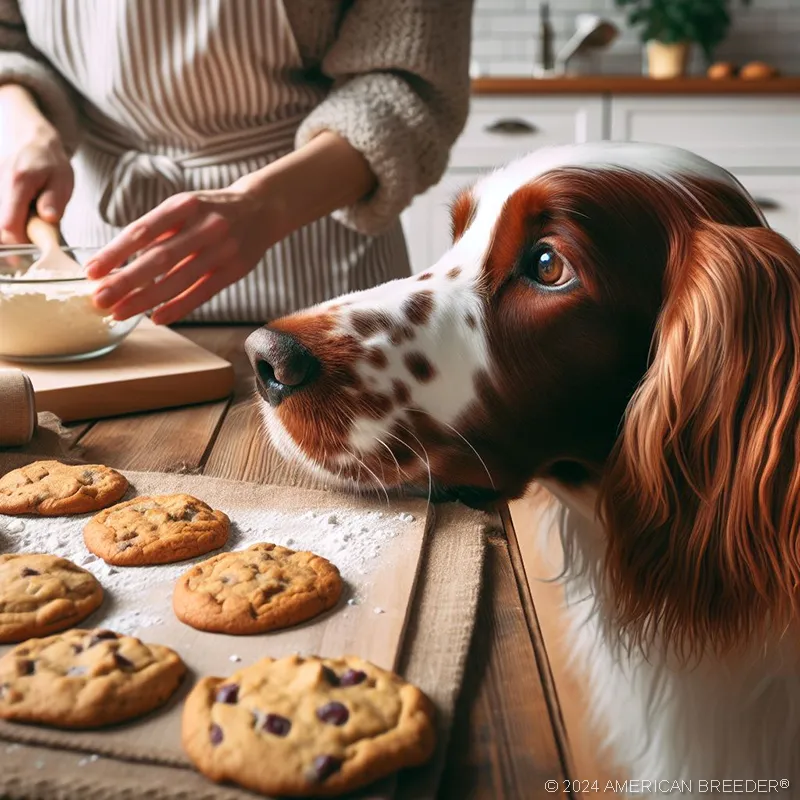The Irish Red and White Setter: An In-Depth Breed Guide
Introduction
 The Irish Red and White Setter, often simply referred to as the Irish Setter, is a breed with a rich history and a distinct appearance. Originating in Ireland, these dogs were initially bred for their hunting prowess, particularly in the field of bird retrieval. They are medium to large-sized dogs known for their elegant and athletic build. One of their most striking features is their beautiful coat, which typically showcases a combination of red and white markings.
The Irish Red and White Setter, often simply referred to as the Irish Setter, is a breed with a rich history and a distinct appearance. Originating in Ireland, these dogs were initially bred for their hunting prowess, particularly in the field of bird retrieval. They are medium to large-sized dogs known for their elegant and athletic build. One of their most striking features is their beautiful coat, which typically showcases a combination of red and white markings.
These dogs are not only prized for their physical attributes but also for their friendly and affectionate nature. They make excellent family pets, known for their loyalty and sociable demeanor. Their playful and gentle temperament makes them great companions for children and adults alike. However, it's important to note that they are an active breed with specific needs in terms of exercise, training, and grooming.
Breed Background and History
Origins and Development
The history of the Irish Red and White Setter can be traced back several centuries in Ireland. They were initially bred for their hunting skills, primarily in setting and retrieving game birds. The breed's ancestors are believed to include a mix of spaniels, pointers, and early Irish water spaniels. Over time, a distinction emerged between the solid red Irish Setter and the red and white variety, which we now know as the Irish Red and White Setter.
Historical Significance and Cultural Relevance
The Irish Red and White Setter holds a special place in Irish culture, often referred to as the "gentleman's hunting dog." They were favored by the aristocracy and played a significant role in the sport of bird hunting. Today, they are less common in the field but have found their niche as beloved family pets and show dogs.
 Purpose and Original Use
Purpose and Original Use
Originally, these dogs were bred for their hunting abilities. Their keen sense of smell and agile bodies made them exceptional bird dogs. They would "set" or crouch down to indicate the location of game birds to hunters and retrieve downed birds with a gentle mouth. While many Irish Red and White Setters still excel in hunting trials, their friendly nature and adaptability have also made them popular as companion animals.
Kennel Clubs that Classify, Group, or Register
The Irish Red and White Setter is recognized by various kennel clubs and breed organizations worldwide. Notably, they are recognized by The Kennel Club in the United Kingdom and the American Kennel Club (AKC) in the United States. The AKC classifies them under the "Sporting Group," reflecting their hunting heritage.
Appearance
The Irish Red and White Setter boasts an elegant appearance that captures the hearts of many. Here, we explore their size, weight, coat type, colors and patterns, and distinctive features.
Size and Weight
Irish Red and White Setters are a medium to large-sized breed. Males typically stand between 24 to 26 inches at the shoulder, while females are slightly smaller, ranging from 22 to 24 inches. Their weight can vary, with males weighing between 70 to 80 pounds and females between 60 to 70 pounds.
Coat Type, Colors & Patterns
One of the most distinctive features of the Irish Red and White Setter is their coat. It is typically long, silky, and feathered, with a fine texture. The coat's base color is white, adorned with deep red or chestnut-colored patches. The distribution of these patches can vary, with some dogs having a more evenly distributed pattern, while others may have larger solid patches of red.
Distinctive Features
Beyond their coat, Irish Red and White Setters have several distinctive features. They have expressive, almond-shaped eyes that are typically dark or hazel in color. Their ears are set at eye level, framing their face. The breed's head is proportionate to its body, with a well-defined stop and a black or dark brown nose. Their tail is moderately long, tapering to a fine point and covered in feathering.
Average Litter Size
Irish Red and White Setters typically have litters that range in size from 5 to 8 puppies. As with all breeds, factors like the age and health of the mother can influence litter size. Responsible breeding practices prioritize the health and well-being of both the mother and her puppies.
Temperament and Personality
The Irish Red and White Setter is known for its friendly and affectionate temperament. In this chapter, we explore their energy level, loyalty, friendliness to pets and strangers, trainability, playfulness, barking tendencies, chase instincts, sense of smell, and drive to hunt.
Energy Level - Irish Red and White Setters are an energetic breed. They have a zest for life and enjoy outdoor activities, making them a great choice for active individuals or families. Daily exercise is essential to keep them happy and healthy.
 Loyalty - Loyalty is one of the defining traits of this breed. They form strong bonds with their families and are known to be particularly devoted to their owners. This loyalty is often reciprocated, as owners of Irish Red and White Setters often become deeply attached to their canine companions.
Loyalty - Loyalty is one of the defining traits of this breed. They form strong bonds with their families and are known to be particularly devoted to their owners. This loyalty is often reciprocated, as owners of Irish Red and White Setters often become deeply attached to their canine companions.
Friendliness to Pets and Strangers - These dogs tend to be friendly and sociable, both with other pets in the household and with strangers. Proper socialization from a young age helps reinforce their friendly disposition and ensures they get along well with other dogs and animals.
Trainability - Irish Red and White Setters are generally intelligent and eager to please, which makes them highly trainable. However, they do have a playful streak, so training should be engaging and fun. Positive reinforcement techniques work particularly well with this breed.
Playfulness - Playfulness is a hallmark of the Irish Red and White Setter's personality. They have a youthful exuberance that lasts well into adulthood. Interactive playtime and engaging toys are essential to keep them mentally and physically stimulated.
Barking Tendencies - While not known to be excessive barkers, Irish Red and White Setters may bark to alert their owners to something unusual or exciting. Early training can help manage their barking tendencies and ensure it doesn't become a nuisance.
Chase Instincts - These dogs have a strong natural instinct to chase, which harks back to their hunting heritage. It's important to manage this instinct, particularly around smaller animals, to prevent chasing behavior.
Sense of Smell - Irish Red and White Setters possess an excellent sense of smell, which served them well in their hunting days. This keen olfactory sense can sometimes lead them to interesting scents during walks, so be prepared for the occasional detour.
Drive to Hunt - While many Irish Red and White Setters no longer serve as hunting dogs, some retain a strong drive to hunt. Engaging in activities like nose work or scent training can help satisfy this instinct.
Health and Care
The health and well-being of your Irish Red and White Setter are paramount to ensuring a happy and fulfilling life. In this chapter, we will explore common health issues, allergies, lifespan, grooming requirements, exercise needs, and guidelines for nutrition and preventive care.
Common Health Issues - While generally a healthy breed, Irish Red and White Setters can be prone to certain health issues. These may include hip dysplasia, progressive retinal atrophy (PRA), hypothyroidism, and autoimmune disorders. Responsible breeders conduct health screenings to minimize the risk of these conditions in their puppies.
Allergies - Some Irish Red and White Setters may be prone to allergies, which can manifest as skin irritations, ear infections, or gastrointestinal issues. Identifying and addressing allergens in their environment or diet is essential to keep them comfortable.
 Lifespan - The typical lifespan of an Irish Red and White Setter ranges from 11 to 15 years. Providing proper care, nutrition, regular exercise, and regular veterinary check-ups can contribute to a longer and healthier life for your beloved pet.
Lifespan - The typical lifespan of an Irish Red and White Setter ranges from 11 to 15 years. Providing proper care, nutrition, regular exercise, and regular veterinary check-ups can contribute to a longer and healthier life for your beloved pet.
Grooming Requirements - The breed's long and silky coat requires regular grooming to keep it in good condition. Brushing several times a week helps prevent mats and tangles, especially in areas with feathering. Regular bathing, nail trimming, and ear cleaning are also essential aspects of their grooming routine.
Exercise Needs - Irish Red and White Setters are an active breed with high exercise requirements. Daily exercise, such as long walks, runs, or playtime in a securely fenced yard, is essential to keep them mentally and physically stimulated. Insufficient exercise can lead to boredom and undesirable behaviors.
Nutrition and Feeding Guidelines - Proper nutrition is key to your dog's health. Feeding high-quality dog food appropriate for their age and activity level is crucial. Portion sizes should be based on your dog's weight, age, and activity level. Consult with your veterinarian for specific dietary recommendations, including feeding schedules and any dietary restrictions.
Vaccination Schedule and Preventive Care - Maintaining a regular vaccination schedule is important to protect your Irish Red and White Setter from common canine diseases. Core vaccines, such as those for rabies and distemper, should be administered as recommended by your veterinarian. Non-core vaccines, like those for kennel cough or leptospirosis, may be considered based on your dog's lifestyle and location. Additionally, regular flea and tick prevention and heartworm prevention are essential aspects of preventive care.
Regular Health Check-ups and Vet Visits - Routine veterinary check-ups are crucial to detect and address health issues early. Annual wellness exams, dental care, and discussions with your vet about your dog's specific needs are essential for their overall health and well-being. Veterinarians can also provide guidance on topics like spaying or neutering and any breed-specific health considerations.
Signs of Potential Health Problems and When to Seek Veterinary Attention - As a responsible owner, it's important to be vigilant about your dog's health. Be on the lookout for signs of potential problems, such as changes in appetite, energy levels, bathroom habits, or the presence of lumps or skin issues. If you notice any concerning symptoms, don't hesitate to seek veterinary attention promptly.
Socialization and Compatibility
Irish Red and White Setters are known for their friendly and sociable nature. This chapter delves into their interactions with children, other pets, and strangers, as well as the importance of socialization, considerations for multi-dog households, and their ease of training.
 Interaction with Children, Other Pets, and Strangers
Interaction with Children, Other Pets, and Strangers
Irish Red and White Setters are typically gentle and friendly, making them great companions for children. They often form strong bonds with kids and enjoy playful interactions. With proper socialization, they can also get along well with other pets and are generally approachable with strangers.
Socialization Needs and Tips for Proper Socialization
Socialization is a critical aspect of raising a well-adjusted Irish Red and White Setter. Exposing them to various environments, people, animals, and situations from a young age helps ensure they grow up to be confident and well-behaved adults. Puppy socialization classes and supervised playdates can be beneficial.
Precautions or Considerations for Multi-Dog Households
When adding an Irish Red and White Setter to a household with other dogs, it's important to consider the dynamics and personalities of all the dogs involved. Proper introductions, supervision during initial interactions, and fair treatment for all pets are key to fostering a harmonious environment.
Level of Ease When It Comes to Training
Irish Red and White Setters are generally intelligent and trainable, making them a suitable choice for both novice and experienced dog owners. They respond well to positive reinforcement techniques, such as treats and praise. Consistency, patience, and structured training sessions are important for success.
Living Arrangements and Environment
Choosing the right living arrangements and creating a suitable environment for your Irish Red and White Setter are vital for their well-being. In this chapter, we discuss the breed's suitability for different living situations, space requirements, climate considerations, and ideal living conditions.
 Suitability for Different Living Arrangements
Suitability for Different Living Arrangements
Irish Red and White Setters adapt well to various living arrangements. They can thrive in urban apartments with active owners or in spacious suburban or rural settings. What matters most is providing them with sufficient exercise and mental stimulation.
Space Requirements and Exercise Options
These active dogs benefit from a home with ample space to move and play. A securely fenced yard is ideal, allowing them to run and explore safely. However, regular exercise routines and mental stimulation activities can also suffice if a large yard is not available.
Climate Considerations and Adaptability
Irish Red and White Setters are adaptable to different climates, but they are more comfortable in temperate conditions. Their long coat can make them sensitive to extreme heat, so precautions like providing shade and water during hot weather are necessary. In cold climates, they may require extra protection from the cold.
Recommended Yard Size
While there is no strict yard size requirement, a medium to large yard is advantageous for Irish Red and White Setters. It allows them space to run and play, which is essential for their well-being. Regular exercise, whether in a yard or on daily walks, is crucial to their happiness.
Ideal Living Conditions and Environment
Creating an ideal living environment involves a combination of physical and mental stimulation, companionship, and proper care. A loving and structured home with regular exercise, playtime, and opportunities for social interaction will contribute to a happy and contented Irish Red and White Setter.
Training and Obedience
Irish Red and White Setters are intelligent and eager to please, making them trainable dogs. In this chapter, we explore basic obedience training, advanced training, behavioral challenges, house training, leash training, and walking etiquette.
 Basic Obedience Training and Commands
Basic Obedience Training and Commands
Basic obedience training is the foundation of a well-behaved Irish Red and White Setter. Teaching commands such as sit, stay, come, and down helps establish communication and control. Consistent training with positive reinforcement methods is key to success.
Advanced Training or Specialized Activities
For owners looking to engage their Irish Red and White Setter in more advanced training or specialized activities, options abound. These dogs excel in various dog sports, such as agility, obedience trials, and field trials
Engaging in these activities not only provides mental and physical stimulation but also strengthens the bond between owner and dog.
Behavioral Challenges and Solutions
Like all breeds, Irish Red and White Setters may exhibit behavioral challenges from time to time. These challenges can include digging, chewing, or barking excessively. Understanding the underlying causes, such as boredom or anxiety, is essential to addressing these issues. Positive reinforcement training techniques, along with consistency and patience, are effective tools for resolving behavioral challenges.
House Training
House training, or housetraining, is an important aspect of raising a well-mannered Irish Red and White Setter. Consistency in schedule and positive reinforcement for eliminating outdoors are key components of successful house training. It's essential to be patient and avoid punishing your dog for accidents.
Leash Training and Walking Etiquette
Leash training is crucial for ensuring that walks with your Irish Red and White Setter are enjoyable for both you and your dog. Starting leash training from a young age helps prevent pulling and ensures your dog walks politely on a leash. Proper leash etiquette, such as yielding to pedestrians and controlling your dog around other animals, is also important.
Exercise and Activity Needs
Irish Red and White Setters have high energy levels and require regular exercise and mental stimulation. This chapter explores their exercise needs, recommended activities, and tips for keeping them engaged.
Exercise Requirements - Irish Red and White Setters thrive on physical activity. They require at least 60 to 90 minutes of exercise each day to keep them mentally and physically fit. Activities such as running, hiking, playing fetch, or engaging in dog sports are excellent ways to meet their exercise needs.
 Recommended Activities
Recommended Activities
Engaging in various activities can help fulfill your Irish Red and White Setter's exercise requirements while providing mental stimulation. Consider activities like:
Fetch: A classic game of fetch is a favorite for this breed. It not only provides physical exercise but also taps into their natural retrieving instincts.
Agility: Agility training or courses challenge your dog's agility and problem-solving skills. It's a fun and stimulating activity for both of you.
Hiking: If you enjoy the outdoors, taking your Setter on hikes allows them to explore new environments while getting exercise.
Swimming: Many Irish Red and White Setters love water. Swimming is an excellent low-impact exercise that can help cool them off on hot days.
Dog Sports: Engaging in dog sports like obedience, agility, or even field trials can provide mental and physical stimulation.
Interactive Toys: Puzzle toys and treat-dispensing toys can keep your dog engaged and mentally stimulated when indoors.
Mental Stimulation - In addition to physical exercise, mental stimulation is crucial for this breed. Their intelligence and problem-solving abilities benefit from activities that challenge their minds. Puzzle toys, obedience training, scent work, and interactive games can provide mental exercise.
Tips for Keeping Them Engaged - To keep your Irish Red and White Setter engaged, rotate activities and toys regularly to prevent boredom. Varying your exercise routines and incorporating training sessions into daily life can also stimulate their minds. The key is to provide both physical and mental challenges to keep them happy and content.
Feeding and Nutrition
Proper nutrition is essential for the health and well-being of your Irish Red and White Setter. This chapter explores their dietary needs, feeding schedules, portion control, food choices, and considerations for puppies and seniors.
Dietary Needs - Irish Red and White Setters require a balanced diet that provides essential nutrients to support their active lifestyle. Look for high-quality dog food that lists meat as the primary ingredient. Protein is crucial for muscle maintenance and overall health.
Feeding Schedule - Establishing a consistent feeding schedule is important. Most adult Irish Red and White Setters do well with two meals a day, while puppies may require three to four smaller meals. Stick to a regular schedule to help with house training and digestion.
 Portion Control - Portion control is essential to prevent overfeeding and obesity. Follow the feeding guidelines provided on the dog food packaging, adjusting the portions based on your dog's age, weight, and activity level. Be mindful of treats and table scraps, as they can contribute to excessive calorie intake.
Portion Control - Portion control is essential to prevent overfeeding and obesity. Follow the feeding guidelines provided on the dog food packaging, adjusting the portions based on your dog's age, weight, and activity level. Be mindful of treats and table scraps, as they can contribute to excessive calorie intake.
Food Choices - Choosing the right type of dog food is crucial. Opt for well-balanced commercial dog food, whether dry kibble or canned food. Consult with your veterinarian to determine the best food choice for your individual dog. Avoid feeding human food that can be harmful to dogs, such as chocolate, grapes, or foods high in sodium.
Considerations for Puppies and Seniors - Puppies have different nutritional needs than adult dogs. They require a diet formulated for growth and development. Senior Irish Red and White Setters may benefit from a diet tailored to their age, which can include joint supplements to support aging joints. Consult with your veterinarian for specific dietary recommendations at different life stages.
Grooming and Maintenance
The elegant coat of the Irish Red and White Setter requires regular grooming and maintenance. In this chapter, we delve into grooming routines, tools, bathing, brushing, ear cleaning, nail trimming, and dental care.
Grooming Routine - Establishing a grooming routine is essential to keep your Setter's coat in top condition. A typical grooming routine may include brushing, bathing, ear cleaning, nail trimming, and dental care. The frequency of these tasks depends on your dog's individual needs.
Tools for Grooming - Investing in the right grooming tools makes the process more efficient and comfortable for both you and your dog. Essential grooming tools for Irish Red and White Setters include a slicker brush, pin brush, comb, nail clippers or a grinder, ear cleaning solution, and a dog-specific toothbrush and toothpaste.
Bathing - Irish Red and White Setters do not require frequent bathing unless they get exceptionally dirty. Bathing every 6 to 8 weeks or when they develop that "doggy smell" is usually sufficient. Use a mild dog shampoo to prevent skin irritation.
Brushing - Regular brushing helps prevent mats and tangles in their long, silky coat. Brush your Setter's coat several times a week to keep it in good condition. Pay special attention to areas with feathering, such as the legs, tail, and ears.
 Ear Cleaning - Irish Red and White Setters are prone to ear infections due to their floppy ears that can trap moisture. Regular ear cleaning with a veterinarian-recommended solution can help prevent infections. Be gentle when cleaning and avoid inserting anything deep into the ear canal.
Ear Cleaning - Irish Red and White Setters are prone to ear infections due to their floppy ears that can trap moisture. Regular ear cleaning with a veterinarian-recommended solution can help prevent infections. Be gentle when cleaning and avoid inserting anything deep into the ear canal.
Nail Trimming - Nail trimming is important to prevent overgrowth, which can be uncomfortable for your dog and lead to gait issues. Trim the nails regularly, but be cautious not to cut too close to the quick, which can cause bleeding. If you're unsure, consult a professional groomer or veterinarian for guidance.
Dental Care - Dental hygiene is often overlooked but essential for your dog's overall health. Brushing your Setter's teeth regularly, providing dental chews or toys, and scheduling professional dental cleanings with your veterinarian can help maintain good oral health.
Final Thoughts
Owning an Irish Red and White Setter can be a rewarding and fulfilling experience. These loyal, affectionate dogs thrive in loving homes where they receive proper care, exercise, and training. By understanding their breed-specific traits and needs, you can provide a wonderful life for your Irish Red and White Setter and enjoy a lasting bond with your canine companion.
Remember that responsible ownership involves ongoing learning and adaptation. Stay connected with breed clubs, veterinarians, and fellow Setter owners to continue growing your knowledge and providing the best possible care for your beloved Irish Red and White Setter.
Thank you for choosing this comprehensive guide as your resource for all things related to the Irish Red and White Setter. We hope it serves as a valuable companion throughout your journey as a Setter owner, helping you provide the best life for your furry friend.
If you ever have questions or need assistance with specific issues related to your Irish Red and White Setter, don't hesitate to reach out to breed-specific clubs, veterinarians, trainers, or online communities dedicated to this wonderful breed. Wishing you and your Setter many years of happiness, health, and shared adventures!
Irish Red and White Setter Dog Quick Reference Guide
Breed Background: Origin: Ireland | Breed Purpose: Bird hunting | AKC Class: Sporting Group | Year Recognized by AKC: 2009 Appearance: Size: Medium to large | Weight: 50 to 70 pounds | Coat Type: Silky, feathered | Colors & Patterns: White with red patches | Distinctive Features: Almond-shaped eyes, long ears
Appearance: Size: Medium to large | Weight: 50 to 70 pounds | Coat Type: Silky, feathered | Colors & Patterns: White with red patches | Distinctive Features: Almond-shaped eyes, long ears
Temperament: Energy Level: 4/5 | Loyalty: 5/5 | Friendliness to Pets: 4/5 | Friendliness to Strangers: 4/5 | Trainability: 4/5 | Playfulness: 4/5 | Frequent Barker: 3/5 | Chase Instincts: 5/5 | Sense of Smell: 5/5 | Drive to Hunt: 5/5
Health & Care: Health Issues: Hip dysplasia, PRA, autoimmune disorders | Lifespan: 11-15 years | Grooming Difficulty: Moderate | Exercise Needs: High
Socialization: Interaction with Children: Good with proper socialization | Interaction with Pets: Usually good | Interaction with Strangers: Friendly | Elderly Compatibility: May require moderate exercise | Ease of Training: Moderate
Suitable Living Arrangements: Apartment: Not ideal | House: Preferred | Rural Area: Ideal | Yard Size Requirements: Large yard beneficial
Training & Obedience: Trainability: 4/5 | Intelligence: 4/5 | Obedience: 4/5 | Problem-Solving: 3/5 | Easily Stimulated: 5/5 | Focus Level: 4/5 | Easily Distracted: 3/5
Financial Planning: Typical Price Range: $1,000 - $2,500 | Initial Expenses: Puppy, supplies, vaccinations | Ongoing Annual Expenses: Food, grooming, vet visits
Breeding: Reproductive Maturity: Around 6-8 months | Litter Frequency: Typically once a year | Litter Size: 6-10 puppies | Stud Cost: Varies widely | Breeding Challenges: Health screenings, finding suitable mates
Did You Enjoy this Article? Share it and Help Us Spread the Word!
If you found this article helpful, we'd appreciate it if you could share it with your friends or link to it from your website, blog, or group! You can also use the convenient social share tabs on the left side of the screen to instantly share this page to your social media feed. For more ways to support and promote the American Breeder Community, visit our Share & Promote Together page for social media posts and memes you can copy and share. Your support means the world to us!
Disclaimer: The information provided in this article is for general informational purposes only and does not constitute legal, medical, financial, or professional advice. While we strive for accuracy, we make no representations or warranties regarding the completeness, accuracy, reliability, or suitability of the information. Please consult with a professional before making decisions based on the content provided. American Breeder Inc. assumes no responsibility for any errors or omissions or for the results obtained from the use of this information.
